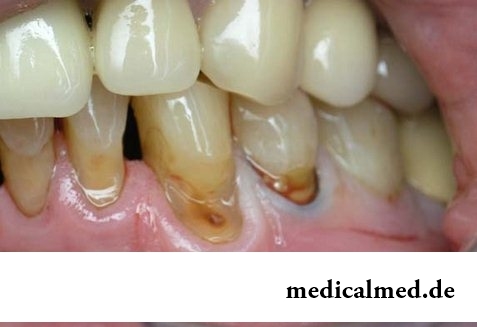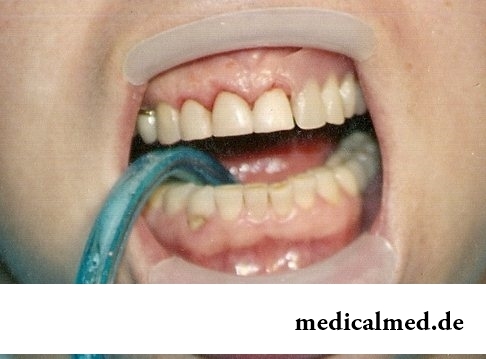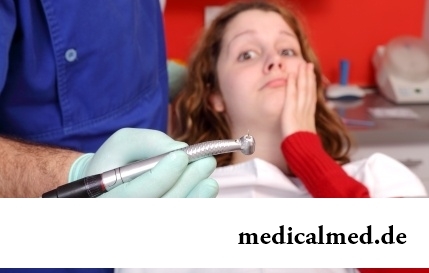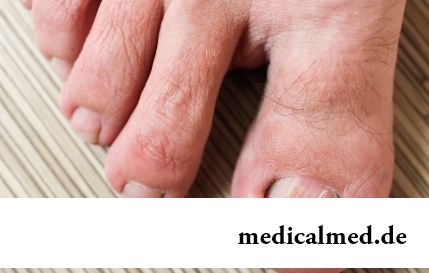





Wedge-shaped defect of teeth

Wedge-shaped defect is a V-shaped defeat of solid tooth fabrics from the outer side most of which often occurs at patients of advanced and middle age. Pathology of this disease meets both in single, and in multiple manifestation, as a rule, on frontal symmetric teeth (canines), or on premolar tooths (a small molar). Wedge-shaped defect on the buccal and lip surfaces of teeth in cervical area is localized, and in a form it is similar to the triangle directed by the top towards a pulp cavity.
Diagnosing of wedge-shaped defect
It is possible to diagnose wedge-shaped defect in two ways:
- in the presence of external manifestations when defect of enamel in cervical area of tooth is expressed as a step of a V-shaped form (wedge). Manifestation of wedge-shaped defect is frequent after the tooth neck at defeat of a parodont (peridental fabric) is bared. Unlike caries wedge-shaped defect has the polished and smooth struck surface
- at emergence in the person of painful feelings from impact of mechanical, chemical or temperature influences. This diagnostic method is used in rare instances as wedge-shaped defect, as a rule, is not followed by pain at an initial stage.
Wedge-shaped defect needs to be differentiated not only from caries, but also from a tooth erosion.
Etiology of emergence of wedge-shaped defect
Men of science from stomatology still "break a spear" about an actual reason which provokes wedge-shaped defect of teeth. Let's try to consider three main theories of emergence of V – figurative change. Anyway, each of these theories has the right for existence and, the most interesting – each of them can lead to defect development.
- Erosion (chemical theory). It is considered that impact on enamel of tooth of aggressive acid chemical environment (both liquid, and gaseous) – a various citrus, carbonated drinks, juice, etc. – lead to emergence and progressing of wedge-shaped defect.
- Abrasion (mechanical theory). Means systematic mechanical impact on teeth firm foreign bodys, as leads to defect emergence. Can lead use of a rigid toothbrush to this disease. At the same time at right-handed persons the disease is more expressed on the left side, and at lefthanders – with right.
- Loading (physicomechanical theory). The increasing number of doctors-gnatologov incline that wedge-shaped defect of teeth is a result of disturbance of occlusion, in other words, of a bite. If it is short, then each tooth is obliged to assume a certain loading which, at the correct bite is uniform. If the bite is broken, then the most part of efforts when processing food is accepted by one of teeth. As a result of a horizontal depreciation bend of tooth around a neck where, by the way, enamel is thinner, there is a cracking in the beginning, and then wedge-shaped defect is formed.
Clinical picture
Wedge-shaped defect is characterized by brilliant, smooth walls. Through fabrics the pulp which is never opened can be illuminated. At early stages it looks in the form of a crack or a graze which extends and begins to resemble a wedge. A firm bottom, an equal bottom and the polished walls – one of characteristics of this disease. At the same time the tooth neck exposure is observed. Wedge-shaped defect, as a rule, is not followed by pains since process flows rather slowly and deposits of replaceable dentine manage to prevent emergence of painful effect. At the started forms of a disease there is a risk of an otlom of a tooth crown. Patients most often see a doctor because of an esthetic problem which is visible at a smile.
Treatment of wedge-shaped defect

Treatment of wedge-shaped defect at early stages is accompanied by elimination of the injuring factors. The exception of abrasive pastes and powders and rigid brushes is for this purpose made. Experienced dentists, in bigger weight, already decided on the point of view that before beginning treatment of wedge-shaped defect, the integrated analysis of occlusion is necessary. Vrach-gnatolog after detection of the injuring factors will perform optimization of a bite, thereby having eliminated a major factor of developing of a disease.
Ways of treatment of wedge-shaped defect
- The conservative way is used at initial stages of a disease. It includes applications by the remineralizing means, namely solutions of a gluconate of calcium, sodium fluoride, use of various varnishes and ointments. This way of treatment is carried out in a complex using toothpastes which lower sensitivity. The remineralizing therapy is used, as a rule, to two times a year.
- Treatment of wedge-shaped defect at more started stage demands more radical methods of treatment which include sealing using SITs (stekloionomerny cement) or modern composition materials. It should be noted the fact that sealing not always solves a problem, though is one of widespread options of treatment.
- Installation of vinir in some cases allows to achieve that the cause of illness is removed, and considerably the dentition esthetics improve.
- Installation of ceramic-metal or bezmetallovy crowns is also an efficient solution of the problem of wedge-shaped defect. Though, exists probability that under a crown defect will continue to progress
In the conclusion it is necessary to pay attention that all ways and methods of treatment of wedge-shaped defect which are listed above are applied in each separate case after careful studying of a problem by your stomatologist. Treatment of wedge-shaped defect – rather individual, long-term and labor-intensive process. In this case the understanding from the patient is necessary, and the professional stomatologist will do everything possible to return you joy of an open and light smile.
Most of women is capable to derive more pleasure from contemplation of the beautiful body in a mirror, than from sex. So, women, you aim at symmetry.

Many of us, probably, noticed more than once that from intellectual loadings at some point the brain as though "overheats" also "assimilation"...
Section: Articles about health
Work of a brain is extremely complex and in many respects is not studied yet. It is confirmed also by the features of thought processes which are shown when the person sleeps. Let's tell about some of them....
Section: Articles about health
Statistically, can only one of ten of our compatriots brag of a decent condition of an oral cavity. Six teeth affected with caries are the share of the average Russian. For comparison, this indicator for Europeans is almost six times less....
Section: Articles about health
Stability of a hormonal background is one of the most important conditions of preservation of health of the woman. At the same time endocrine system –...
Section: Articles about health
In consciousness of our many compatriots idea that folk remedies if are no more effective, than medicinal "chemistry" strongly took roots, then are precisely less harmful. Unfortunately, it is not always fair: some receptions treating...
Section: Articles about health
Heart disease and blood vessels lead to disturbance of blood supply of bodies and fabrics that involves failures in their work, deterioration in health of the person, decrease in its working capacity and standard of living. Annually more than 17 million inhabitants of our planet perish from pathologies such....
Section: Articles about health
Deciding to get rid of an addiction, not all imagine what effects it is necessary to face. Process of refusal from ку...
Section: Articles about health
During foot walks blood moves on vessels more actively and one and all bodies are supplied with a large amount of oxygen. It affects the state of health of the person very positively....
Section: Slideshow
Epilepsy is one of widespread neurologic diseases. Parents, whose children suffer from this illness, should face rumors and delusions, many of which remained since the Middle Ages....
Section: Articles about health
Sugar - the digestible refined product which is not of special value for an organism of the modern person. Use...
Section: Articles about health
Use of medicinal plants in therapy is urgent today, more than ever. The drugs made of curative herbs cannot replace completely modern synthetic drugs, but their use becomes frequent serious help in simplification a leak...
Section: Articles about health
Each person supports all life a SARS about 200 times. The peak of incidence falls on cold season, but it is possible to get sick with a temperature and a pharyngalgia, and sometimes and very possibly, even during a heat. The reasons for development of catarrhal diseases there is a set: from the weakened immunity till an excess portion of ice cream....
Section: Articles about health
Partial and the more so full loss of hearing significantly reduces quality of life. Difficulties with communication lead to loneliness and замкн...
Section: Articles about health
Statistically, pathologies of a thyroid gland in the world more than 500 million people have. Failures in work of this body lead to heavy disbolism, development of heart diseases, vessels, a reproductive and nervous system. In hard cases excessive...
Section: Articles about health
For the time being the perspective of heart diseases seems to most of people remote and foggy. But sooner or later practically each adult faces extremely unpleasant feelings: sudden stethalgia. To be consoled at this time in a thought of what for a heart attack still early, will hardly turn out: if the person is impressionable, he, as a rule, has feeling of panic and fear of fast death. And meanwhile, it is very often possible to confuse pains with cardiac pains невралгическог...
Section: Articles about health
All got used long ago that, having addressed the plastic surgeon, it is possible to modify natural parameters of a figure or to reduce...
Section: Articles about health
Bees – really unique beings. Practically all products of their life activity are used by the person. Since the most ancient times medicinal properties of honey and other substances received in the course of beekeeping are known. The fact that all these пр is especially significant...
Section: Articles about health
The word "onikhokriptoz" is unfamiliar to most of people, meanwhile quite so physicians call very widespread problem: the growing of edge of a nail into surrounding fabrics causing inflammatory process. Usually the illness affects thumbs of legs, and is followed by reddening, hypostasis, and in the started cases – release of pus. Patients complain of the pain amplifying when walking, problems with the choice of footwear....
Section: Articles about health
Ayurveda - the most ancient tselitelsky practice which came to us from India. It represents the doctrine about maintenance physical, ps...
Section: Articles about health
The technique of acupuncture (acupuncture) is used in the medical purposes more than three and a half millennia. It is eurysynusic and recognized as official medicine in the majority of the developed countries of the world. Influence by fine needles on so-called points...
Section: Articles about health
What woman does not dream of a beautiful and thick hair? While physicians developed difficult schemes on hair transplant, in the industry of hairdresser's art a few years ago there was a sensation – methods of hair extension appeared. It would seem, dreams came true: though the procedure of building also does not belong to the category cheap, practically any woman can increase several times the volume of hair, change their length and color – generally, to become the real beauty queen....
Section: Articles about health
Dark circles (bruises) under eyes – a shortcoming with most of which often fight against the help of cosmetics (proofreaders, salons...
Section: Articles about health
The drugs stopping or oppressing life activity of pathogenic microorganisms are widely applied in clinical practice from 40th years of the last century. Originally antibiotics were called only substances natural (animal, vegetable or микробног...
Section: Articles about health
The modern person not always manages to find housing in the environmentally friendly region and such work which would not do harm to health. With food stuffs at first sight the situation is much better: shops are overflowed with goods which are positioned by producers as very useful and absolutely safe. Many Russians are absolutely sure that the choice of products with marking "bio", "эко" or "organik" guarantees them and members of their families an optimal variant of food. To a sozhala...
Section: Articles about health
The advantage of swimming for the person is so high that this sport is not only the most popular, but also is widely applied in copper...
Section: Slideshow
Life does not indulge the modern woman special emotional comfort and carelessness. The fatigue, troubles at work, misunderstanding in a family and various illnesses immediately affect a condition of hair and skin. And to look safe and attractive so хоч...
Section: Articles about health
Transfusion of donor blood has almost century history. In spite of the fact that this procedure is quite usual for many people, process of blood donation is still surrounded with numerous myths. Today we aimed to discredit the most widespread of them....
Section: Articles about health
